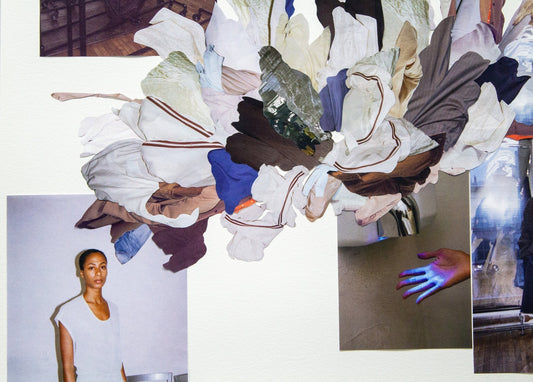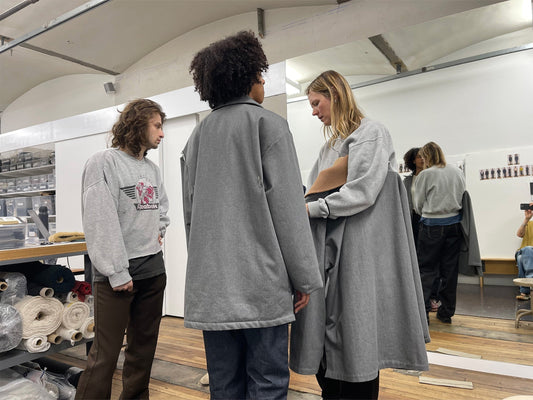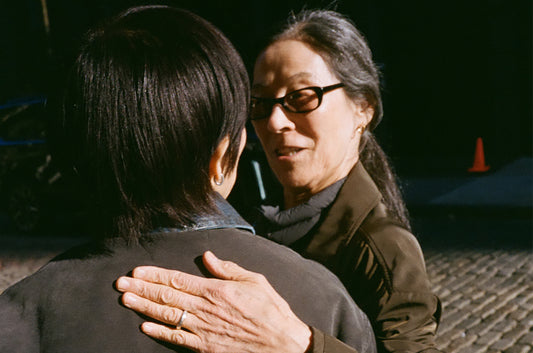
Jenny Smith, who has worked closely with me and 6397 for 15 plus years, told me about Rina’s work and something she had in mind incorporating concepts of her work using 6397 photos. It sounded so interesting and I said “let’s try it”. That was maybe late Spring and Jenny and Rina have been working on it ever since. The results are so beautiful that we felt we had to share it with you.
Enjoy.
-Stella


For the past couple of years, our visual language has been shaped by photographer Peter Sutherland, whose documentary realism captures the raw, unpolished grit where urban and personal life collide. In thinking about our Pre-Fall collection - I thought it interesting to take Peter’s work and treat it as a new canvas. I handed Peter’s photography over to fellow New York creative Rina Kim, a collage artist known for building surreal, imagined worlds. The result an exercise in reassembly, disrupting the original look book and finding creativity in cutting up and reimagining what was.
This spirit of deconstruction feels appropriate right now, when many things around us feel broken. Rina’s work a simple reminder that we have the power to reassemble and reimagine our future.
Below Rina shares with us a bit about her process, and how she began collaging.
-Jenny

Talk to me about making one of your collages, what's your process like?
I typically like to “warm up” by sifting through a stack of old fashion magazines or catalogues. Depending on my mood that day, or whatever colors I’m attracted to at the time, I’ll make cut-outs of various sizes either with scissors or an x-acto knife and group them chromatically. Any cut-out pieces I don’t use right away get stored in shoeboxes labeled with corresponding colors/tones.
Then I’ll start arranging the cut-outs by hand, using small pieces of blue tape to hold them together temporarily. This allows the flexibility that I need in my process, in case anything needs rearranging or shuffling as the work begins to take shape. They start out pretty small, and it’s quite challenging to know how far to take them. Sometimes I need to step away for a moment or even pause for a few days so I can look at the work in progress with a fresh pair of eyes and decide whether to keep going, or to start gluing!


What drew you to collaging - do you remember when you started the practice of collaging?
(Rina) I first began working with collage during undergrad. What drew me in was how accessible it felt – the fact that you could work with found imagery and materials instead of spending money on expensive tools like canvas or paint. That freedom made collage feel egalitarian and democratic, like anyone could participate. Around that time, I was also really influenced by artists like Martha Rosler, Romare Bearden and Hannah Höch, and became fascinated by how they used collage as a subversive tool, working within the realms of (re)appropriation to critique and reframe culture.
As I started to explore collage more seriously, I began making connections to remix culture, bootlegging, and other practices rooted in recontextualization. These discoveries were instrumental, because I realized there’s something inherently radical about taking a preexisting image and forcing it to speak a new language. Artists like Arthur Jafa and Sarah Sze expanded my thinking even further, pushing the medium into immersive, multimedia spaces that resist easy consumption or flattening. What does it mean to create something that can’t be consumed through an Instagram scroll?
In a time when we’re constantly bombarded with streams of images and information, collage helps me slow down. It emphasizes the very act of looking intently. The process is tactile and meditative, which has become increasingly necessary in today’s digital landscape that’s fast and fleeting. People are often surprised to hear my work is all analog, and not Photoshopped.
I’m also drawn to the ethics of reuse, of working with what’s already been produced. In the age of AI, when human creativity can feel overshadowed or threatened, collage feels like a form of rebellion. It’s a way to reimagine what we’ve inherited and make it personal again.
I notice that you often use cut-outs of fabrics and/or clothing in your collages. Is that true and if so, is there a reason for that? Was it always that way?
In the beginning, I mostly experimented with skin and anatomy, but eventually fabric/clothing felt more akin to brushstrokes or painterly gestures that I wanted to mimic. I like the organic quality to them, suggestions of a bodily form underneath the layers. There’s air, movement or stillness.
I continue to incorporate cut-out hands that are also sourced from the same fashion magazines. They evoke so much emotion - desire, seduction, demureness. This 1982 Martha Rosler performance piece where she flips through an issue of Vogue Magazine is one of my favorite references that I keep coming back to.


Do you have a go-to publication that you use for cut outs when making your art?
I don’t have a specific go-to, but I tend to gravitate toward magazines that are more editorial-forward, ones with strong visual narratives and bold styling. I’ve been fortunate to be on a few editorial shoots in my professional career, which gave me a deeper appreciation for the talent, labor and creativity that goes into producing those spreads. When I reuse them in my work, it comes from a place of admiration. The subversive or rebellious nature of collage is more about interrogating the broader systems behind the imagery, and not the craft itself.
I also really enjoy the randomness of using whatever comes my way. I’m grateful for friends and acquaintances who pass along their unwanted magazines and print media, which adds a layer of chance and unpredictability. There’s something exciting about the challenge of working with whatever finds its way to me.



What are you listening to?
My summer playlist! And lots of Marcos Valle. 80’s R&B, always.
What organization(s) do you want to support / are important to you right now?
I don’t know if anything else feels more dire than what’s currently going on in Gaza right now - @letstalkpalestine has this great resource for all ongoing fundraisers to support various food/medical initiatives or displaced families. I also like to support the good folks at Slow Factory, and their new platform/publication Everything is Political so that we can move away from corporate/mass media and combat misinformation.

Thank you, Rina !
@rinaroundmidnight





